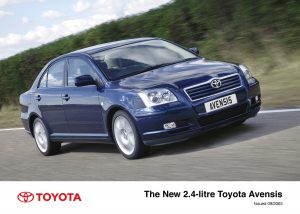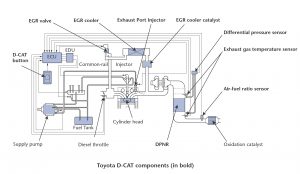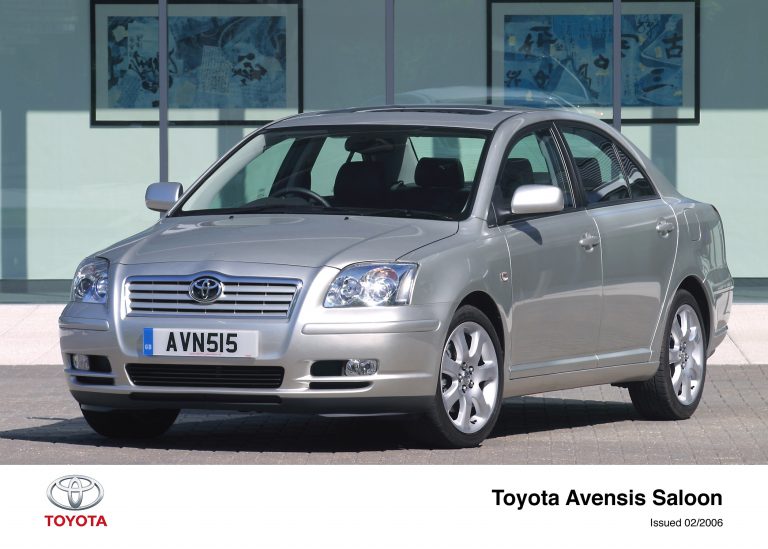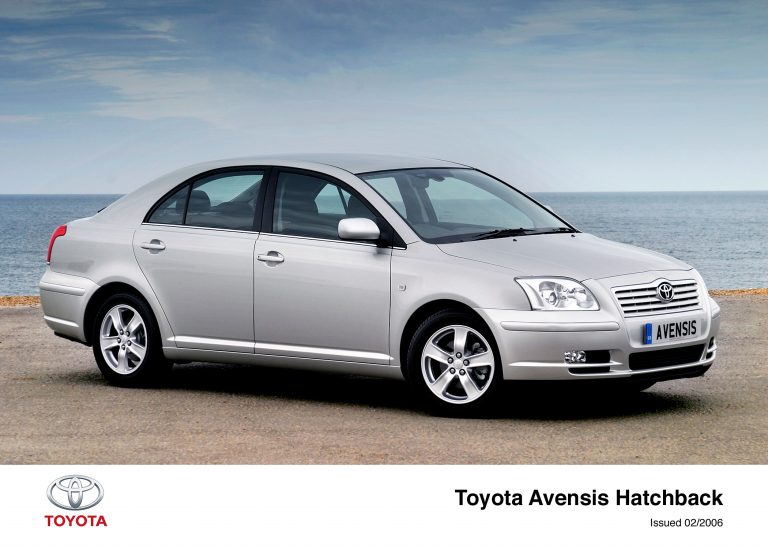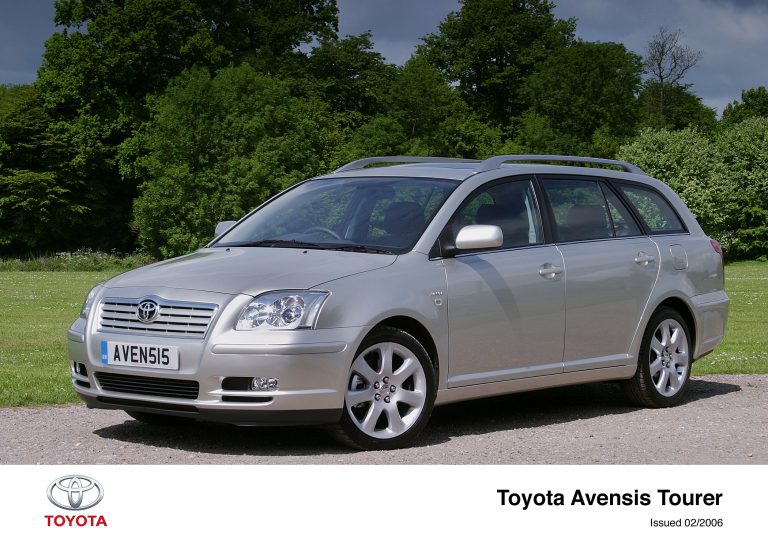Two New Engines For Toyota Avensis
D-2.0 D-CAT, the world’s cleanest diesel, and flagship 2.4 Di petrol units to complete the new Avensis range
Key points
- 2.0-litre D-CAT world’s cleanest diesel engine for NOx and PM emissions
- New maintenance-free DPNR four-way catalyst able to reduce NOx and PM levels simultaneously
- No fuel additives required
- Emissions levels of NOx and PM substantially below Euro IV requirements
- No loss in performance: acceleration and maximum speed match that of Avensis
- 2.0 D-4D
- 114bhp at 3,600rpm; 280Nm of torque from 2,000 to 2,200rpm
- Available in UK in T3-X, T4 and T Spirit saloon models from early 2004
- 2.4-litre direct injection petrol engine, new flagship engine for Avensis
- Most powerful engine yet used in an Avensis model – 161bhp at 5,800rpm and 230Nm of torque at 3,800rpm
- 0 to 62mph acceleration in 9.1 seconds
- Available in UK in T4 and T Spirit saloon and hatchback models from early 2004
- 2.4-litre Di engine matched to new five-speed sequential multi-mode automatic transmission
Toyota is launching a new era of clean diesel engine performance with the introduction of the Toyota 2.0-litre D-CAT (Diesel Clean Advanced Technology) engine, the world’s cleanest diesel in terms of nitrogen oxides and particulate emissions. At the same time, Toyota is bringing to market a new 2.4-litre Di direct injection petrol unit, the flagship engine of the Avensis range.
The 2.0 D-CAT engine delivers low levels of harmful nitrogen oxides (NOx), hydrocarbon (HC) and particulate (PM) emissions, far below the demands of Euro IV legislation. In this respect, its emissions performance makes it the world’s cleanest diesel engine.
Like the advances in hybrid power technology in the new generation Prius, the introduction of D-CAT demonstrates Toyota’s continuing commitment to engineering vehicle powertrains that have a less harmful impact on the natural environment.
The four-cylinder 2.4 Di engine is the largest capacity direct injection petrol engine in the European D segment and is matched to a new, lightweight five-speed multi-mode automatic transmission. It is the first time Toyota has combined a five-speed automatic with a four-cylinder engine, achieving useful gains in torque from a transmission that is lighter and more compact than the four-speed unit.
NEW LEVELS OF CLEAN DIESEL PERFORMANCE
The Toyota D-CAT system was first shown as a concept in 2000. In early 2004 it will become a production reality with D-CAT making its debut in the new Avensis range and offering new low levels of exhaust emissions for a production diesel engine.
Toyota D-CAT achieves its ground-breaking clean performance through the integration of a series of advanced engine technologies. In creating the engine, Toyota took the existing 2.0-litre D-4D and modified or added 30 key components. The advances made are witnessed by Toyota being granted 1,622 new patents for the development of the system.
At the heart of the D-CAT engine is the DPNR (Diesel Particulate NOx Reduction) four-way catalyst. This marks a world first in achieving continuous and simultaneous filtering of nitrogen oxides and particulate matter in exhaust emissions.
The DPNR catalyst was created by incorporating a particulate filter into the three-way NOx catalyst used in Toyota’s lean-burn petrol engine. Its effective operation relies on the engine management system being able to vary the fuel-air ratio in the exhaust gases. This has been made possible with the addition of a fifth injection nozzle, located in the exhaust port. At a critical moment, fuel is injected downstream of the exhaust manifold to create the right operating conditions in the DPNR catalyst. This ‘rich’ spike allows the DPNR catalyst to release and reduce the NOx it has stored.
The unit is maintenance free (a ‘health check’ is recommended every 20,000 miles) and requires no fuel additives. It is, however, designed to work to maximum efficiency using low-sulphur diesel, fuel that is now readily available at UK forecourts.
The D-CAT system makes its debut with the 2.0-litre D-4D engine, which uses Toyota’s second generation high pressure common rail direct injection system. This is capable of developing injection pressure of 180 MPa, regardless of engine speed, and achieves an interval between the end of pre-injection and the start of the main injection of 0.4 milliseconds – the shortest of any engine currently available.
The D-4D engine was among the very first Euro IV-compliant diesel engines to reach the marketplace when new Avensis was launched on 1 March. Now D-CAT takes its NOx and PM emissions to even lower levels – 50 and 90 per cent respectively below Euro IV levels.
This achievement is not at the expense of performance. Provisional output figures for the Toyota 2.0 D-CAT are 114bhp at 3,600rpm and 280Nm of torque from 2,000 to 2,200rpm. It will power the Avensis from 0 to 62mph in 11.2 seconds and achieve a top speed, where permitted, of 122mph, matching the performance of the standard 2.0 D-4D engine.
The 2.0 D-CAT produces carbon dioxide emissions of 161g/km, compared to 155g/km for the 2.0 D-4D. These engines currently have no direct market competitors that meet the Euro IV emissions standards. Within the D segment, Volkswagen and Audi offer a Euro IV-compliant 2.5-litre V6 TDI engine that produces 186g/km of CO2 in the Passat and 189g/km in the A4.
REFINED AND POWERFUL 2.4 Di PETROL ENGINE
Toyota’s new 2.4-litre direct injection petrol engine is the largest capacity Di unit to be offered in the European D segment. Producing 161bhp at 5,800rpm and 230Nm of torque at 3,800rpm, it is the most powerful engine yet to be used in an Avensis. It provides acceleration from rest to 62mph in 9.1 seconds and reaches a maximum speed, where permitted, of 137mph.
The new engine is a development of the 2.4 VVT-i unit used in the Toyota Previa, but achieves a higher output and greater torque at a lower engine speed: output is up by 7bhp and maximum torque by 5Nm.
To enable the direct injection system to be fitted, it uses a revised engine head made from lightweight magnesium alloy. This has been engineered to eliminate higher noise levels associated with high pressure injection, an issue that is also addressed by the introduction of twin balancer shafts. Using a variable air intake improves engine efficiency and creates an environment for stable combustion.
NEW FIVE-SPEED MULTI-MODE AUTOMATIC TRANSMISSION
The new 2.4 Di engine also marks the arrival of a new five-speed multi-mode automatic transmission. It is the first five-speed unit Toyota has offered with a four-cylinder engine and, although it produces higher levels of torque than four-speed units, it is both lighter and more compact. The use of five speeds and a higher final gear ratio aids acceleration and fuel economy.
The transmission is also equipped with a multi-mode system that lets the driver choose between fully automatic or sequential gear changes. By putting the gear lever into “S”, the driver can take greater control of the shift pattern, simply by moving the lever backwards or forwards. Unlike most sequential systems, the Toyota transmission allows the driver to select a gear range, rather than one specific gear. For example, by shifting up to “3”, the car will automatically use first, second or third gear according to vehicle speed and road conditions; similarly, selecting “4” will extend the range to include fourth gear.
More responsive gearshifts are achieved thanks to a clutch-to-clutch pressure control system and centrifugal fluid pressure-cancelling. A logic system operates to help keep gearchanges to a minimum, recognising when the car is travelling on winding roads with hilly sections or long inclines and holding an appropriate gear for longer.
UK MARKET INTRODUCTION
The Toyota Avensis 2.4 Di and 2.0 D-CAT will go on sale in the UK early in 2004. The 2.4 Di will be available in T4 and T Spirit saloon and hatchback body styles and will benefit from High-Intensity Discharge (HID) headlamps above the regular model specification. Introduction of the 2.4 Di Tourer model will be confirmed next year. The 2.0 D-CAT will also be launched at the beginning of the year, available in T3-X, T4 and T Spirit saloon models. Prices and further details will be announced nearer the time of launch.
TECHNICAL SPECIFICATIONS
|
ENGINE |
2.4-litre Di petrol |
2.0-litre D-CAT |
|
Cylinder head material |
Aluminium alloy |
Aluminium alloy |
|
Engine block material |
Aluminium alloy |
Cast iron alloy |
|
Fuel type |
95 octane (or greater) |
48 cetane diesel (or greater) |
|
Injection type |
Electronic, direct injection |
Direct injection, common rail |
|
Injection pressure (MPa) |
8-13 |
180 |
|
Emissions control system |
Two three-way catalysts, heated oxygen sensor |
DPNR with oxidation catalyst |
|
Valve mechanism |
DOHC 16-valve VVT-i |
DOHC 16-valve |
|
Displacement (cc) |
2362 |
1995 |
|
Bore x stroke (mm) |
88.5 x 96.0 |
82.2 x 94.0 |
|
Compression ratio |
11.0:1 |
17.8:1 |
|
Max power (bhp/rpm) |
161 @ 5,800 |
114 @ 3,600 |
|
Max torque (Nm/rpm) |
230 @ 3,800 |
280 @ 2,000-2,200 |
|
PERFORMANCE |
||
|
0-62mph |
9.1 |
11.2 |
|
Max speed (mph) |
137 |
122 |
| FUEL CONSUMPTION (mpg)/EMISSIONS (g/km)/VED RATING | ||
| Combined (Tourer) |
29.7(29.4) |
46.3 |
| Extra-urban (Tourer) |
39.2 (38.7) |
55.4 |
| Urban |
20.9 |
36.2 |
| CO2 emissions (Tourer) |
227 (228) |
161 |
| NOx emissions |
0.03 |
0.11 |
| PM emissions |
– |
0.002 |
| THC & NOx emissions |
– |
0.15 |
| CO emissions |
– |
0.21 |
| VED band |
D |
B |
| TRANSMISSION | ||
| Drive type |
Front-wheel drive |
|
| Gearbox type |
5-speed A/T |
5-speed M/T |
| Gear ratios | ||
| First |
4.235 |
3.538 |
| Second |
2.360 |
1.913 |
| Third |
1.517 |
1.258 |
| Fourth |
1.047 |
0.918 |
| Fifth |
0.756 |
0.690 |
| Reverse |
3.378 |
3.583 |
| Final drive |
3.478 |
3.684 |
ENDS

